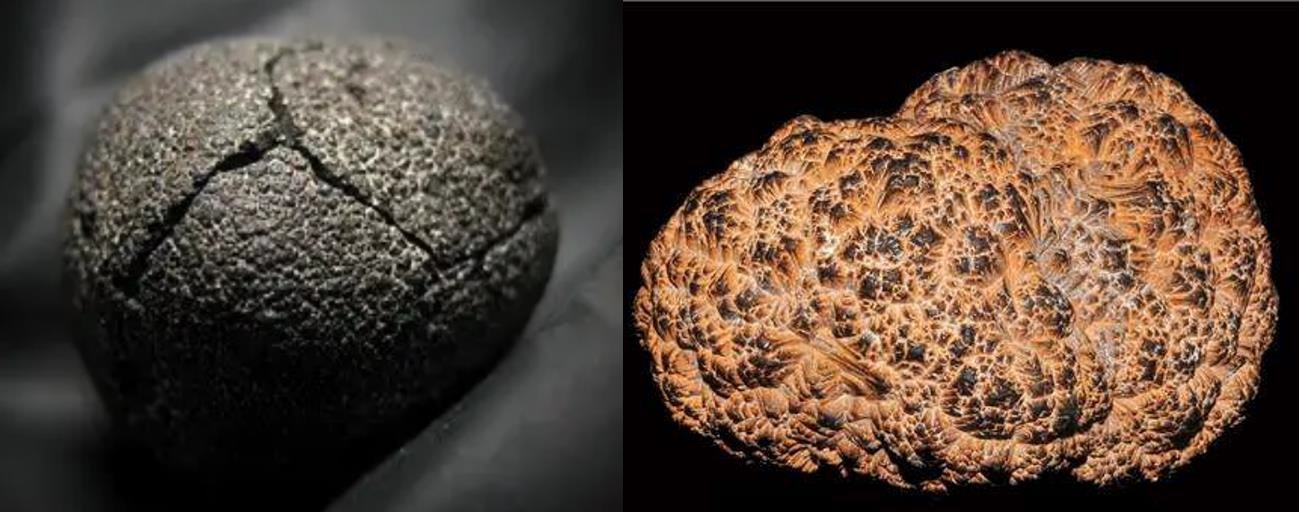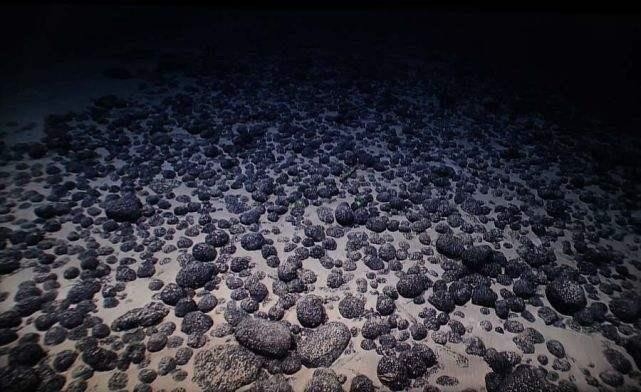
跟着东说念主类斯文的抵制跳动和科技发展的日月牙异,东说念主类对资源的探索已慢慢由陆地转向海洋。1872 年,英国一艘名为“挑战者”号的海洋探望船在加那利群岛功课时白丝 sex,初次在海洋中发现矿块。该矿块呈玄色或棕褐色,形似马铃薯,裹着厚厚的金属颗粒。因颗粒的主要要素是锰和铁,故有东说念主称其为“海洋金属结核”或“海洋锰结核”。
哔哩哔哩官网在线观看With the continuous progress of human civilization and the rapid development of science and technology, human exploration of resources has gradually shifted from land to sea. In 1872, a British marine survey vessel named “Challenger” was operating in the Canary Islands when it first discovered one kind of ore nodule in the ocean. The nodule was black or brown in color, shaped like a potato and covered with thick metal particles. Since the main components of the particles are manganese and iron, some people call the nodule “marine metal nodule” or “marine manganese nodule”.

海洋锰结核结构组成
Structural composition of marine manganese nodule
海洋锰结核多以贝壳、鱼齿、珊瑚片、岩屑等为中枢及围绕它的壳层组成。其存在局势主要为硅酸盐和难溶性高锰酸盐,化学要素比较复杂,除含锰、铁、铜、钴、镍、铅等常见金属外,还含有钛、钼、锆、镭、镧、铊等养息金属。
Most of the marine manganese nodules are composed of shells, fish teeth, coral fragments and rock chips as well as the shell layer around it. The chemical composition is relatively complex, containing not only common metals such as manganese, iron, copper, cobalt, nickel and lead, but also rare metals such as titanium, molybdenum, zirconium, radium, lanthanum and thallium.
海洋锰结核的物资组成取决于熔岩喷发区地幔深处的物资组成。由于不同海区地层中的元素含量不同,故太平洋、印度洋和大泰西中的锰结核化学要素各有别离。此外,海洋锰结核的体式、硬度等因熔岩喷发强弱程度而存在权贵互异。能量大,温度高的熔岩喷发酿成的锰结核个体大,质量较硬;反之,能量小、温度低的熔岩喷发所酿成的锰结核个体小,硬度较低[1]。
The material composition of marine manganese nodules depends on the material composition deep in the mantle of the lava eruption area. The chemical composition of manganese nodules in the Pacific Ocean, Indian Ocean and Atlantic Ocean is different because the elemental content in the strata of different sea areas is different. In addition, the shape and hardness of marine manganese nodules vary significantly depending on the intensity of lava eruptions. The manganese nodules formed by high-energy and high-temperature lava eruptions are large and hard; conversely, the manganese nodules formed by low-energy and low-temperature lava eruptions are small and less hard.

Factors of forming marine manganese nodule
对于海洋锰结核成因问题的征询,科学家主要围绕三个问题进行: 锰结核元素的供给源来自那处?锰结核的千里积方位是如何酿成的?锰结核的滋长机理是什么?
The research on the formation of marine manganese nodules has focused on three questions: Where does the source of supply of manganese nodule elements come from? How are the deposition sites of manganese nodules formed? What is the growth mechanism of manganese nodules?
锰结核元素的供给源主要来自四个方面:a.来知足陆各式金属元素,千里积到海洋之中酿成;b.来自海底火山喷发,火山气体和海水互相作用后金属元素进入海水后千里积;c.来自海洋浮游生物,浮游生物升天后体内的金属元素进入海底千里积;d.来自天地空间,每年简略有几千吨天地尘埃进入地球,它们富含金属元素,证实后进入海洋。
The supply sources of manganese nodules are as follows: a. They are from various metallic elements in the continents which are deposited into the ocean; b. They are from the volcanic eruptions under the sea where metallic elements are deposited after the interaction between volcanic gases and seawater; c. They are from the marine plankton where metallic elements in the plankton’s body are deposited under the sea after death; d. They are from the cosmic space whose several thousand tons of cosmic which are rich in metallic elements dust enter the earth every year and go into the sea after decomposition.
锰结核的千里积方位酿成:金属元素通过各式渠说念和搬运神色,来到具备酿成锰结核的“核”上,经由漫长的岁月,酿成大小不等的锰结核。在征询这些金属元素的搬运神色上,科学家无数以为是通过海水熔化自后到锰结核的“核”上的[2]。
The formation of manganese nodules deposition sites: The metallic elements come to the “nucleus” with the ability to form manganese nodules through various channels, and after a long period of time, manganese nodules of different sizes are formed. In studying the transport of these metallic elements, scientists generally believe that they come to the “nucleus” of manganese nodules through dissolution of seawater.
锰结核的滋长机理一般有三种说法:a.生物成因,锰结核的金属开头于千里降到海底的海洋动物遗骨,当它们被生存在结核名义的底栖微生物食用后,使金属蚁合,慢慢使锰结核增长;b.火山成因,锰结核是由海底火山及由此产生的火山岩的大意蚀变,使岩石中含有的金属被淋滤,经由千里淀而酿成的;c.自生化学千里积,锰结核的金属源自海水和千里积物的孔隙水,河流将大陆上的某些金属元素和千里积物带到海中,经由自生化学千里积作用而酿成锰结核[3]。
People think there are three kinds of growth mechanisms of manganese nodules: a. Organism. The metal of manganese nodules comes from the bones of marine animals that sink to the bottom of the sea, and when they are eaten by the benthic microorganisms living on the surface of the nodules, the metals accumulate and gradually make the manganese nodules grow; b. Volcano. The manganese nodules are formed by the slow alteration of the volcanoes on the sea floor and the resulting volcanic rocks, so that the metals contained in the rocks are leached and precipitated; c. Authigenic chemical deposition. The metals of manganese nodules originate from the pore water of seawater and sediments, and rivers bring certain metallic elements and sediments from the continents to the sea which can form the manganese nodules through authigenic chemical deposition.

海洋锰结核散播范围
海洋锰结核的开拓才气主要有以下三种:
1. 水力培植式采矿系统,用集矿安设在海底把锰结核挑选、蚁集在全部,用高压水泵把它们通过采矿管培植到船里;
2. 空气培植式采矿系统,用高压空气泵通过输气管将压缩空气打到海底,把海底锰结核连同水和睦从采矿管压到船里;
3. 邻接链斗式采矿系统,用链斗把矿石运上来。
There are three main mining methods for marine manganese nodules as follows.
1. Hydraulic lift mining system: manganese nodules are selected and collected together on the seabed by collecting devices, and lifted into the ship through the mining pipe by high-pressure pumps.
2. Air-lift mining system. The compressed air is pumped to the seafloor by high-pressure air pumps through the air pipeline, and the seafloor manganese nodules, together with water and gas, are pressed from the mining pipe to the ship.
3. Continuous rope mining method. The ore is brought up by a chain bucket.

气举泵培植暗示图
Schematic diagram of air-lift mining system
问题与瞻望 Problems and prospects现在,建树海洋锰结核靠近技巧、经济和政事等多方面的风险,是一项耗资弘远、风险极高的工程。比拟于陆地几千米深的矿井,在海底挖掘的难度远高于地表外层。深不行测的海底环境,对深海功课的装备条件极高,不仅要承受深层海水的压力和腐蚀,还要对抗海洋的复杂洋流。除了深海采矿技巧方面的不及,经济投资亦然一项辣手问题。矿业投老本就不同于其它投资,建树周期长,投资凯旋慢,不细则性大。海洋矿业更甚于陆地,导致很少有企业进行经济干预。
At present, the development of marine manganese nodules faces many technical, economic and political risks, and is a very costly and risky project. Compared with a mine shaft thousands of meters deep on land, it is much more difficult to mine on the seafloor than in the outer layers of the earth’s surface. The mysterious and unpredictable environment of the seafloor places great demands on the equipment used in deep-sea operations, which must not only withstand the pressure and corrosion of deep seawater, but also the complex currents of the ocean. In addition to the technical shortcomings of deep-sea mining, economic investment is also a difficult issue. Mining investment is inherently different from other investments, with long development cycles, slow payoffs and high uncertainty. This is even more true for marine mining than for land-based mining, resulting in little economic investment.
尽管海洋锰结核的建树存在多种不细则因素,但其生意性建树仅仅时刻问题。一是因为越来越多的国度正进入工业化发展阶段,对金属的需求量快速加多;二是因为金属矿产资源不行再生,相配是易处置的富矿越来越少。此外,相干海洋矿产开拓技巧的发展也加速了海洋锰结核的建树程度。
Despite the multiple uncertainties surrounding the development of marine manganese nodules, it is only a matter of time before they are commercially exploited. Firstly, more and more countries are entering the industrial development stage and the demand for metals is increasing rapidly; secondly, metal mineral resources are non-renewable, especially the rich ores that are easy to handle are becoming less and less available; thirdly, the development of related marine mineral mining technology has also accelerated the process of marine manganese nodule development.
参考文件[1] Hein J R, Staudigel H, et al. Seamount mineral deposits: a source of rare metals for high-technology industries[J]. Oceanography, 2010, 23(1), 184-189.
[2] 周怀阳. 深海海底铁锰结核的私密[J]. 当然杂志, 2015, 37(6), 397-404.
[3] Baturin G N, Dubinchuk V T, et al. Hydrothermal manganese mineralization in the Peterbourgskoye ore field (North Atlantic)[J]. Oceanology, 2014, 54(2), 222-230.
[4] 牛京考. 大洋多金属结核建树征询述评[J]. 中国锰业, 2002, 20(2),23-29.
References:
[1] Hein J R, Staudigel H, et al. Seamount mineral deposits: a source of rare metals for high-technology industries[J]. Oceanography, 2010, 23(1), 184-189.
[2] Zhou Huaiyang. Metallogenetic mystery of deep-sea ferromanganese nodules[J]. Chinese Journal of Nature, 2015, 37(6), 397-404.
[3] Baturin G N, Dubinchuk V T, et al. Hydrothermal manganese mineralization in the Peterbourgskoye ore field (North Atlantic) [J]. Oceanology, 2014, 54(2), 222-230.
[4] Niu Jingkao. Research and development of oceanic multi-matal nodule[J]. China Manganese Industry, 2002, 20(2),23-29.